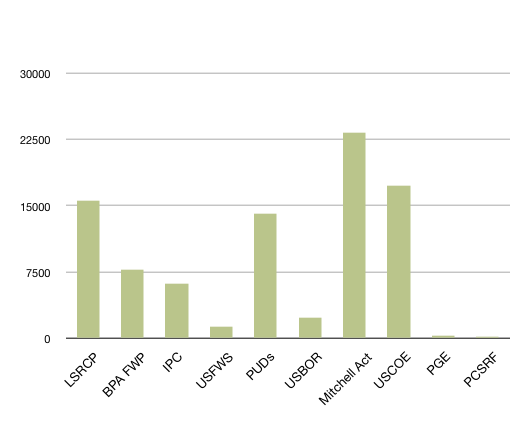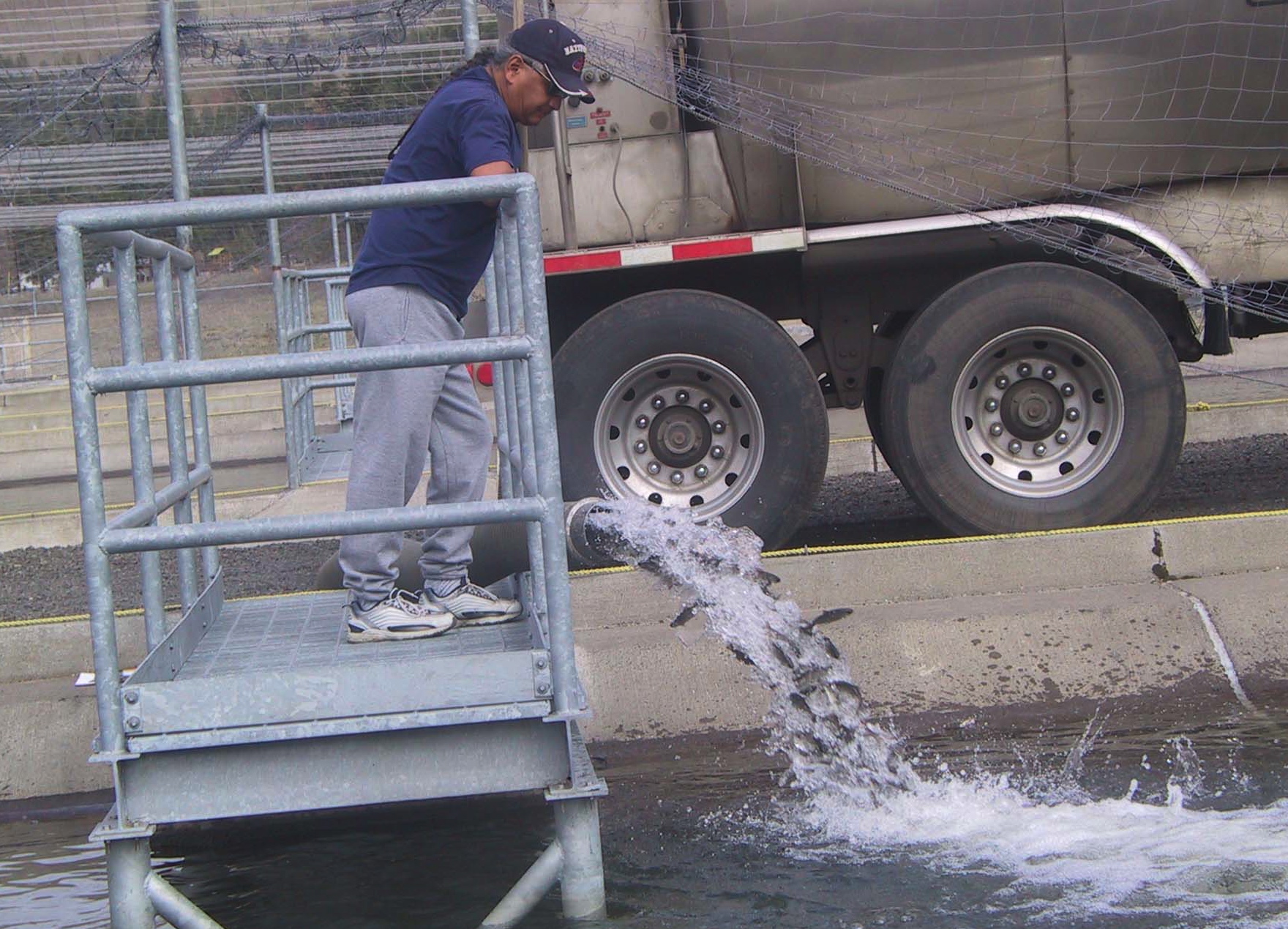Institutional Recommendation 7
Tribal Hatchery Management
Transfer certain federally funded hatcheries to tribal control.
Current Status
Hatchery programs produce fish for a number of purposes: harvest augmentation, supplementation, conservation/recovery and fish reintroduction. In 1995 when the initial the Spirit of the Salmon Plan was published, all hatcheries in the Columbia Basin were managed by state or federal agencies, with the four tribes having little or no influence on decisions regarding program operations. While the situation has not changed for the hatchery programs operated below Bonneville Dam, of the 42 hatcheries that produce anadromous fish in the interior basin, the tribes are now primary managers of 6 of them (Table 1), and 2 other hatcheries operate with a combination of tribal and federal management staff (Table 2). The remaining 34 hatcheries continue to be operated by state or federal agencies, although operational plans (broodstock management and production and release methodologies) for each facility are developed with significant input from the tribes (Table 3). For details, see Appendix C 2008-2017 U.S. v. Oregon Management Agreement Production Tables, revised May 31, 2012.
Table 1: Tribally Managed Hatcheries
| Hatchery | Subbasin | Management Agency |
| Parkdale FH | Hood R | Warm Springs Tribe |
| Levi George (Cle Elum) FH | Yakima R | Yakama Nation |
| Prosser FH | Yakima R | Yakama Nation |
| Klickitat FH | Klickitat R | Yakama Nation |
| Nez Perce Tribal FH | Clearwater R | Nez Perce Tribe |
| Kooskia NFH | Clearwater R | Nez Perce Tribe |
Note: The Chief Joseph FH (Columbia River mainstem) was recently completed and is operated by the Confederated Tribes of the Colville Reservation. The Crystal Springs FH to be operated by the Shoshone-Bannock Tribes for supplementation of the upper Salmon River is currently under construction.
Table 2: Shared Management Hatcheries
| Hatchery | Subbasin | Management Agency |
| Warm Springs NFH | Deschutes R | Warm Springs & USFWS |
| Dworshak NFH | Clearwater R | Nez Perce & USFWS |
Table 3: Hatcheries with Tribal Advisory Input
| Hatchery | Subbasin | Management Agency |
| Eagle Creek NFH | Clackamas R | USFWS |
| Carson NFH | Wind R | USFWS |
| Willard NFH | Little White Salmon R | USFWS |
| Little White Salmon NFH | Deschutes R | USFWS |
| Spring Creek NFH | Columbia mainstem | USFWS |
| Leavenworth NFH | Yakima R | USFWS |
| Entiat NFH | Entiat R | USFWS |
| Winthrop NFH | Methow R | USFWS |
| Hagerman NFH | Snake R mainstem | USFWS |
| Bonneville FH | Columbia mainstem | ODFW |
| Cascade FH | Columbia mainstem | ODFW |
| Irrigon FH | Columbia mainstem | ODFW |
| Oxbow FH | Columbia mainstem | ODFW |
| Umatilla FH | Columbia mainstem | ODFW |
| Oak Springs FH | Deschutes R | ODFW |
| Round Butte FH | Deschutes R | ODFW |
| Wallowa FH | Grande Ronde | ODFW |
| Lookingglass FH | Grande Ronde R | ODFW |
| Skamania FH | Washougal R | WDFW |
| Washougal FH | Washougal R | WDFW |
| Priest Rapids FH | Columbia mainstem | WDFW |
| Ringold FH | Columbia mainstem | WDFW |
| Eastbank FH | Columbia mainstem | WDFW |
| Wells FH | Columbia mainstem | WDFW |
| Methow FH | Methow R | WDFW |
| Lyons Ferry FH | Columbia mainstem | WDFW |
| Tucannon FH | Tucannon R | WDFW |
| Clearwater FH | Clearwater R | IDFG |
| Rapid River FH | Salmon R | IDFG |
| Pahsimeroi FH | Salmon R | IDFG |
| Sawtooth FH | Salmon R | IDFG |
| McCall FH | Payette R | IDFG |
| Oxbow FH | Snake R mainstem | IDFG |
| Magic Valley FH | Snake R mainstem | IDFG |
| Niagara Springs FH | Snake R mainstem | IDFG |
Note: The Springfield FH to be operated by IDFG to supplement the Red Fish Lake sockeye population is currently under construction.
Mitchell Act funding is responsible for approximately one-third of the fish produced in hatcheries for release above Bonneville Dam (as shown below). However, funding for the Act has remained stagnant, compromising production levels and operation and maintenance needs. The U.S. Army Corps of Engineers and various hydroelectric power companies are responsible for the bulk of the remainder. The U.S. Army Corps of Engineers is planning to meet John Day Mitigation obligations, including construction of new facilities. The 2008 Columbia Basin Accords included a tribal project to reprogram existing John Day Mitigation production to upstream areas. New tribal hatcheries have also been proposed to support tribal coho reintroduction programs in the Yakima and Wenatchee rivers; spring chinook supplementation programs in the Walla Walla, Grande Ronde and Imnaha rivers; and coho and fall chinook mitigation programs in the Klickitat River. The tribes await funding for these facilities.
Production (in millions) of salmon and steelhead juveniles for stocking above Bonneville Dam by funding agency
See Glossary for acronyms. Source: Appendix C. 2008-2017 U.S. v. Oregon Management Agreement Production Tables, revised May 31, 2012.
Assessment
Appropriate management of hatchery production is a key component to realizing conservation and mitigation objectives, including sustainable tribal harvest. While debate continues on the role of hatchery production in the future sustainability of fish runs, judicious integration of hatchery and naturally spawning populations remains an integral part of the tribal approach to restoring fish runs. Direct tribal management of facilities provides greater opportunity to achieve this integration consistent with the overall vision of restoration.
New or Modified Actions
- Identify additional hatchery facilities to transfer to the tribes.
- Ensure adequate funding for existing hatchery programs operated consistent with tribal vision.
- Secure funding for construction and operation of the new tribal hatcheries that have been proposed.
- Develop regional strategy to increase Mitchell Act funding.
- Work with U.S.Army Corps of Engineers to ensure appropriate implementation of John Day Mitigation Project.
- Complete John Day mitigation reprogramming.







